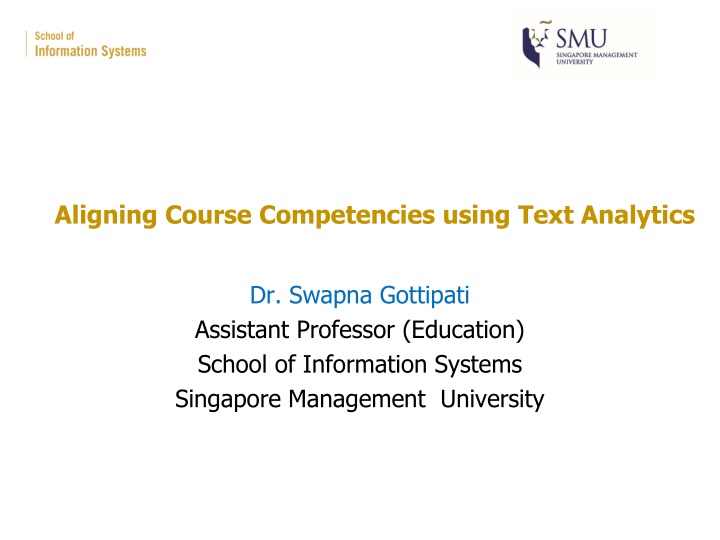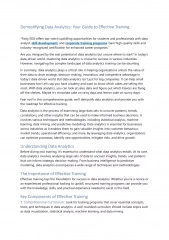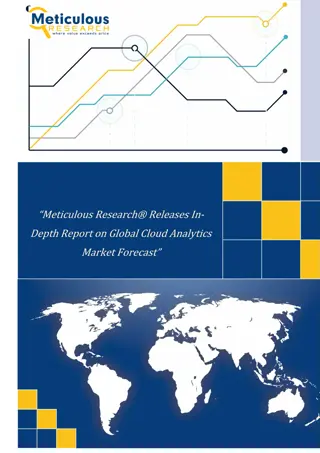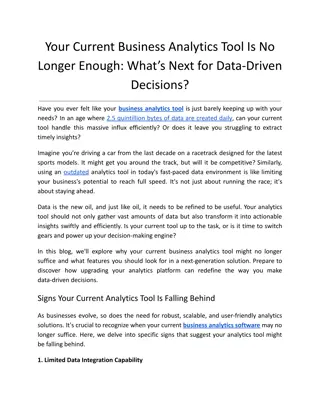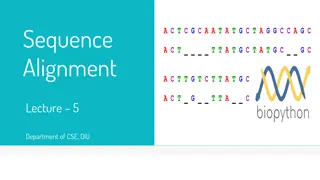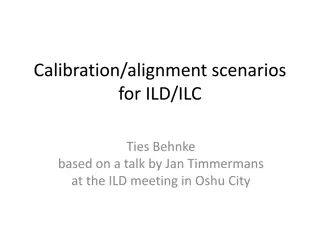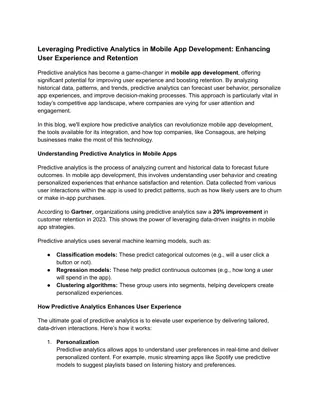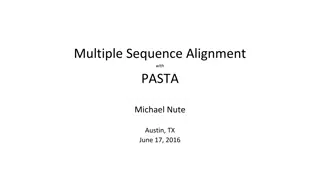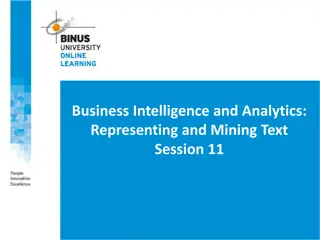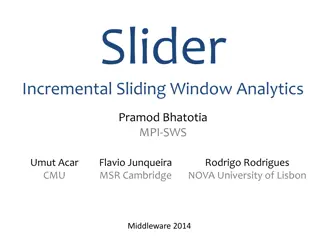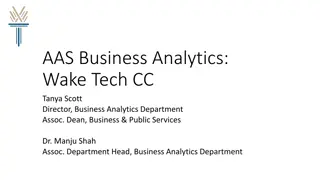Enhancing Course Alignment with Text Analytics in Education
College standards are becoming diluted, leading to confusion in teaching and student expectations. This presentation by Dr. Swapna Gottipati explores aligning course competencies using text analytics. It delves into the importance of aligning assessments, learning objectives, competencies, and teaching activities to enhance student learning and curriculum quality. Motivation, challenges, solutions, and evaluations are discussed to emphasize the significance of course alignment in achieving academic success.
Download Presentation

Please find below an Image/Link to download the presentation.
The content on the website is provided AS IS for your information and personal use only. It may not be sold, licensed, or shared on other websites without obtaining consent from the author.If you encounter any issues during the download, it is possible that the publisher has removed the file from their server.
You are allowed to download the files provided on this website for personal or commercial use, subject to the condition that they are used lawfully. All files are the property of their respective owners.
The content on the website is provided AS IS for your information and personal use only. It may not be sold, licensed, or shared on other websites without obtaining consent from the author.
E N D
Presentation Transcript
Aligning Course Competencies using Text Analytics Dr. Swapna Gottipati Assistant Professor (Education) School of Information Systems Singapore Management University
Introduction College standards are becoming diluted and there is a fuzziness about what faculty teach and what is expected from students. (Miller & Malandra, 2006, p. 3/ Commission on the Future of Higher Education) 2
Background Labs Project Assignments Exams Case studies Quizzes Competency an intended effect of the educational program experiences that has been stated specific, observable, and measurable E.g: Create and evaluate the business process model for a given real world scenario Assessment should be tailored to a specific competency and should be reliable, valid and fair for that 3
What is Course Alignment? Assessments: What kinds of tasks will reveal whether students have achieved the learning objectives I have identified? Learning objectives: What do I want students to know how to do when they leave this course? Competencies Assessments Course Evaluation Teaching activities Instructional activities: What kinds of activities in and out of class will reinforce the learning objectives and prepare students for assessments? We focus on aligning the competencies and assessments in this talk. 4
Why is it important? Enabling teachers to provide students with the opportunities for learn and practice Enabling students to focus their efforts on activities for good grades which are more likely to translate into good learning . Suggesting assessment questions to the teaching staff. Discovering the gaps in the overall curriculum. 5
Agenda Motivation Challenges Solution Evaluations Conclusions 6
Motivation Academic success = what students remember + + students are able to do with their knowledge. Alignment is a way of evaluating the course components. We need a alignment models (methodology) to measure the alignment. ALIGNING TEACHING AND ASSESSING TO COURSE OBJECTIVES, John Biggs 7
Current Alignment Models Training Time Key Features Review and Analysis Time Model 1 day per team and match items, depth of knowledge (Multiple grades); 1 month turnaround for analysis and report. day to train reviewers 1. Qualitative ratings 2. Quantitative results 1. Content matrix 2. Measure of alignment highly predictive of student achievement scores Webb 1 day per team for coding items and benchmarks in matrix; day for readers to complete survey on instruction; 1 week for analysis and report day to train reviewers Has pool of highly trained reviewers SEC 1. Reviewers need to make inferences 2. In-depth review Alignment review takes 1 day per test; Report and analysis takes 1 1 months. Achieve Manual, Slow, Resource intense, Not scalable 8
Porter Model Alignment is perfect if the proportions for the assessment match cell by cell the proportions for the standards. Competencies We need automated methods that leverage the existing alignment models. 9
Goal: How to align the competencies and assessments? Analyse the assessment wrt to the competencies. Analyse assessments of the course to find missing gaps or useful patterns. Measure alignment between the assessments and competencies quantitatively. 10
Challenges Assessments and Competencies are textual in nature Topics are not explicitly specified in any of the documents Manual discovery of the topics and cognition is expensive and burdensome To construct the competency-cognitive and assessment-cognitive matrices, we need a principled method that can automatically; 1. Extract topics from the documents. 2. Extract the cognition domains for each topic from both competencies and assessments 11
Solution Motivation Levels of skills can be discovered with the standard cognitive domain of Bloom s taxonomy. Porter s alignment model uses topics, standards (competencies) and assessments on the cognitive domain to discover alignment. Keyphrase extraction models are the means to extract the important terms or topics from the documents. Sensitivity Alignment Score that uses sensitivity measure, also known as true positive rate. Given the list of topics and the cognitive competencies, we measure to what extent the assessments test the topics at the cognitive levels of competencies. 12
Competency-Assessment Cube Learning Outcomes (Subsumes competencies) Integration Skills Design and development skills Management skills Learning to learn skills Collaboration skills Change management skills Global Skills Social Skills Labs Projects Quiz Topics Exam Case studies Cognitive taxonomy Assignments Assessments 13
Solution Topic (Competency phrase) Assessment Phrase C1 C1 C1 C1 C1 C1 C1 C1 0.93 T1 T1 0.2 0.1 0.0 0.3 0.3 0.0 0.0 0.2 0.0 0.0 0.3 0.2 0.1 0.1 0.3 0.2 T2 T2 to-be option to-be scenario 0.2 0.2 0.3 0.1 0.1 0.2 0.3 0.1 T3 T3 to-be analysis organizational business process path analysis 0.3 0.1 0.1 0.0 0.2 0.1 0.2 0.1 T4 T4 as-is process 14
Evaluations School of Information System s undergraduate course - Process Modeling and Solution Blueprinting Competencies 62 Assessments 4 labs, assignment, project & exam 15
Data Analysis Competencies - Cognitive 140 120 100 80 60 40 20 0 Assessments Analysis by Cognitive Levels Competency Analysis by Cognitive Levels Word cloud for the assessment phrases Word cloud for the competency phrases 16
Data Analysis Topics Competencies Assessments Comprehension Analysis Evaluation Knowledge Synthesis Application Comprehension Analysis Application Evaluation Knowledge Synthesis application model as-is process associate cost associate task 0.00 0.02 0.00 0.00 0.00 0.00 0.00 0.03 0.02 0.00 0.03 0.02 0.00 0.00 0.00 0.00 0.00 0.01 0.00 0.00 0.00 0.00 0.00 0.00 0.00 0.01 0.02 0.02 0.00 0.00 0.00 0.00 0.01 0.02 0.00 0.00 0.00 0.00 0.00 0.00 0.01 0.01 0.00 0.00 0.00 0.00 0.00 0.00 Porter s alignment tables for 4 sample topics in our dataset. 17
Results - Stage1 (Keyphrase Extraction) Phrases Competency Phrases (Topics) Assessment Phrases Assessment Phrases similar to topics Count 55 258 57 Table1: Statistics of the topics, competencies and assessments Topic to-be option to-be analysis organizational business processas-is process Assessment Phrase to-be scenario path analysis Table2: Example topic and corresponding assessment phrase. These phrases might exist in multiple assessments (labs, projects etc). 18
Results - Stage2 (Alignment) Alignment Results The cognitive distribution of competencies and assessments is similar. 19
Results Gaps & Insights Analyse assessments of the course to find missing gaps or useful patterns. The above heatmap shows which topics are assessed and to what extent. 20
Results - Gaps & Insights Assessment rates for topics such as executive view, external entity are at very low level. 21
Results Alignment Score Alignment Score Sensitivity alignment score is 90.8%. Indicates that assessments are highly aligned with the competencies. 22
Results - Analysis 1. Misalignment - Improve the competency definitions Topics (Competency Phrases) missing in assessments business-it misalignment enterprise level executive view hierarchy view Example topics which are missing in the assessments The above topics are not aligned and therefore the competencies can be redefined. 23
Results - Analysis 2. Misalignment - Recommend Questions to the Instructor Topic Missing Assessments Analysis , Comprehension Comprehension Application, Knowledge Application, Knowledge Application, Knowledge business activity business-it misalignment enterprise level executive view hierarchy view Example topics and missing assessments at cognitive levels The above topics are not tested (assessments) and can be suggested to the teaching staff. 24
Conclusions Some topics/keyphrases are noisy or non-coherent. Topics can be improved with external knowledge such as Wiki. Alignment analysis is incomplete without understanding the teaching activities. Our alignment model can be applied at the program level to measure the overall curriculum alignment. 25
Thank you for your kind attention. http://www.mysmu.edu/faculty/swapnag/ http://www.mysmu.edu/faculty/swapnag/ 26
